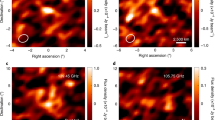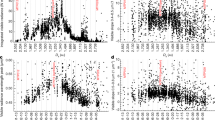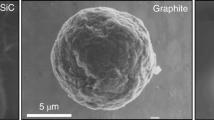Abstract
The timescale for the accretion of bodies in the disk surrounding a young star depends upon a number of assumptions, but there are few observational constraints. In our own Solar System, measurements of meteoritic components can provide information about the inner regions of the nebula, but not the outer parts. Observations of the evolution of more massive protostellar systems (Herbig Ae/Be stars) imply that significant changes occur in the physical properties of their dust with time1. The simplest explanation is that thermal annealing of the original, amorphous grains in the hot inner nebula slowly increases the fractional abundance of crystalline material over time. Crystalline dust is then transported outward, where it is incorporated into comets that serve as a long-term reservoir for dust disks, such as that surrounding Beta Pictoris. Here we show that when applied to our own Solar System, this process can explain observed variations in both the volatile and dusty components of comets, while also providing a natural indicator of a comet's mean formation age. Studies of comets with different dust contents can therefore be used to investigate the timescales of the early Solar System.
This is a preview of subscription content, access via your institution
Access options
Subscribe to this journal
Receive 51 print issues and online access
$199.00 per year
only $3.90 per issue
Buy this article
- Purchase on Springer Link
- Instant access to full article PDF
Prices may be subject to local taxes which are calculated during checkout

Similar content being viewed by others
References
Grady, C. A. et al. Protostars and Planets IV (eds Mannings, V., Boss, A. P. & Russell, S. S.) 613–638 (Univ. Arizona Press, Tucson, 1999).
Smith, B. A. & Terrile, R. J. A circumstellar disk around β Pictoris. Science 226, 1421– 1424 (1984).
Knacke, R. F. et al. The silicates in the disk of β Pictoris. Astrophys. J., 418, 440–450 (1993).
Campins, H. & Ryan, E. V. The identification of crystalline olivine in cometary silicates. Astrophys. J. 341, 1059–1066 (1989).
Ryan, E. V. & Campins, H. Comet Halley: Spatial and temporal variability of the silicate emission feature. Astron. J. 101, 695–701 (1991).
Draine, B. T. & Lee, H. M. Optical properties of interstellar graphite and silicate grains. Astrophys. J. 285, 89–108 (1984).
Prinn, R. G. On neglect of non-linear momentum terms in solar nebula accretion disk models. Astrophys. J. 348, 725– 729 (1990).
Stevenson, D. J. Chemical heterogeneity and imperfect mixing in the solar nebula. Astrophys. J. 348, 730–737 (1990).
Hallenbeck, S. L., Nuth, J. A. & Daukantas, P. L. Mid-infrared spectral evolution of amorphous magnesium silicate smokes annealed in vacuum: Comparison to cometary spectra. Icarus
Hallenbeck, S. L., Nuth, J. A. & Nelson, R. N. Evolving optical properties of annealing silicate grains: From amorphous condensate to crystalline mineral. Astrophys. J. 535, 247–255 ( 2000).
Hanner, M. H. The silicate material in comets. Space Sci. Rev. 90 , 99–108 (2000).
Hanner, M. H., Lynch, D. K. & Russell, R. W. The 8–13 micron spectra of comets and the composition of silicate grains. Astrophys. J. 425, 274 –285 (1994).
Woolum, D. S. & Cassen, P. Astronomical constraints on nebular temperatures: Implications for planetesimal formation. Meteor. Planet. Sci. 34, 897–907 (1999).
Prinn, R. G. & Fegley, B. in Origin and Evolution of Planetary and Satellite Atmospheres (eds Atreya, S. K., Pollock, J. B. & Matthews,M. S.) 78–136 (Univ. Arizona Press, Tucson, 1989).
Fegley, B. in The Chemistry of Life's Origins (eds Greenberg, J. M., Mendoza-Gomez, C. X. & Pirronello, V.) 75–147 (Kluwer, Dordrecht, 1993).
Gerakines, P. A. et al.Observations of solid carbon dioxide in molecular clouds with the Infrared Space Observatory. Astrophys. J. 522, 357–377 (1999).
Weidenschilling, S. J. The origin of comets in the solar nebula: a unified model. Icarus 127, 290–306 ( 1997).
A’Hearn, M. F., Millis, R. L., Schleicher, D. G., Osip, D. J. & Birth, P. V. The ensemble properties of comets: results from narrowband photometry of 85 comets, 1976–1992. Icarus 118, 223–270 ( 1995).
Mumma, M., Weissman, P. & Stern, S. A. in Protostars and Planets III (eds Levy, E. & Lunine, J.) 1177–1252 (Univ. Arizona Press, Tucson, 1993).
Brown, G. N. & Ziegler, W. T. in Advances in Cryogenic Engineering Vol. 25 (eds Timmerhaus, K. D. & Snyder, H. A.) 662–670 (Plenum, New York, 1980).
Lide, David R. Lide (ed.) CRC Handbook of Chemistry and Physics: 75th edn Section 6, 66–76 (CRC Press, Boca Raton, 1994 ).
Acknowledgements
H.G.M.H. & G.K. acknowledge support for this work received under the NAS/NRC Resident Research Associate Program at GSFC. The authors also thank F. Ferguson, D. Fixsen and J. Allen for discussion and technical help with the preparation of the manuscript.
Author information
Authors and Affiliations
Corresponding author
Additional information
Astrochemistry Branch
Rights and permissions
About this article
Cite this article
Nuth, J., Hill, H. & Kletetschka, G. Determining the ages of comets from the fraction of crystalline dust . Nature 406, 275–276 (2000). https://doi.org/10.1038/35018516
Received:
Accepted:
Issue Date:
DOI: https://doi.org/10.1038/35018516
This article is cited by
-
Equilibrium points and stability in the restricted three-body problem with oblateness and variable masses
Astrophysics and Space Science (2012)
-
Compositional homogeneity in the fragmented comet 73P/Schwassmann–Wachmann 3
Nature (2007)
-
Constant of Motion, Lagrangian and Hamiltonian of the Gravitational Attraction of Two Bodies with Variable Mass
International Journal of Theoretical Physics (2007)
-
SD2 – How To Sample A Comet
Space Science Reviews (2007)
-
Crystalline Silicates
Space Science Reviews (2005)
Comments
By submitting a comment you agree to abide by our Terms and Community Guidelines. If you find something abusive or that does not comply with our terms or guidelines please flag it as inappropriate.



